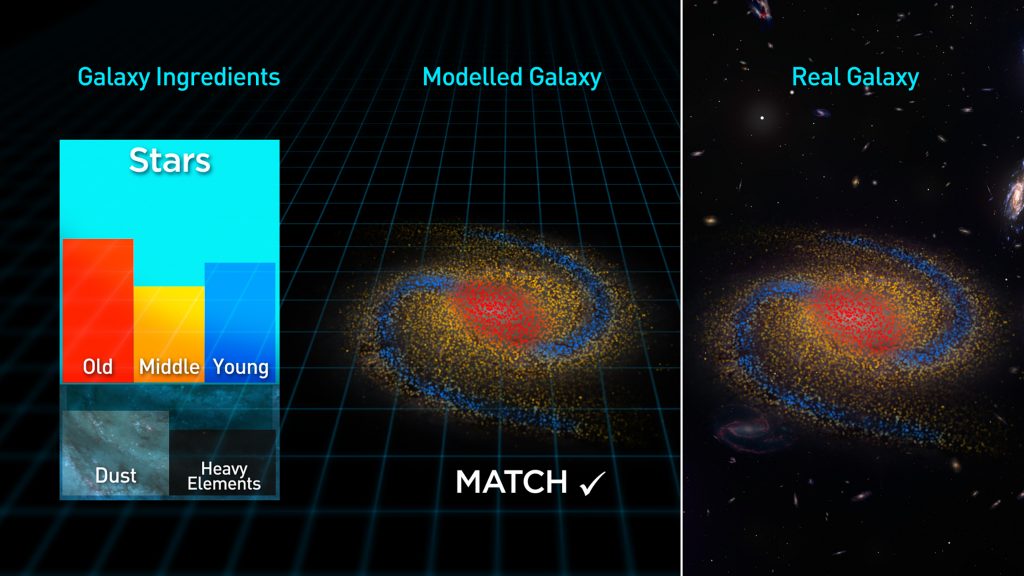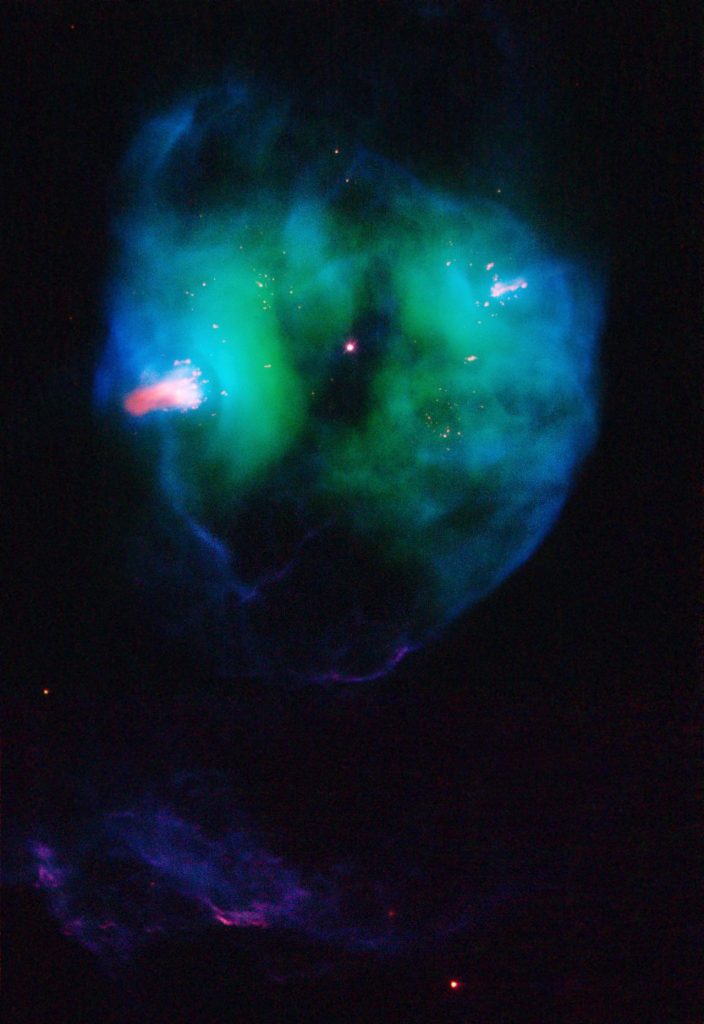Media
Transcript
Today’s science is largely science that has resisted being understood: it’s the science of how star systems form and change the substance of the universe.
At the most basic level, we struggle with questions like “how do stars and planets form?” and “how do stars change the composition of the universe over time?”
For the longest time (by which I mean since we really started trying to model what’s going on) we thought stars had to be well on their way to being fully formed – a million years old or so – before the disks around them began to form planets. In broad brushstrokes, our story said that a collapsing cloud of gas and possibly dust would fragment into cocoons or proplyds in which a star would form.
Over time, the core of this knot of material would become dense enough and hot enough that nuclear reactions would begin, and that protostar would light up and begin interacting with the infalling material around it. Some of the material around the newly forming star would eventually collapse into planets, and a solar system would be born. The exact details of this story have been unclear, and it seems that each new theory has been undone by the next new observation.
Well, today’s newly published observations show that even this level of broad understanding was totally wrong.

New images from the Atacama Large Millimeter/submillimeter Array (ALMA) show evidence of a dust ring with gaps circling IRS 63, a protostar less than 500,000 years old. This co-existence of a forming planetary disk and a forming star seems to indicate that stars and planets form side by side and are roughly the same age.
This work is published in the latest issue of Nature and is led by Dominique Segura-Cox, who writes: We used to think that stars entered adulthood first and then were the mothers of planets that came later. But now we see that protostars and planets grow and evolve together from early times, like siblings.
Co-author Ian Stephens goes on to say: These rings and gaps suggest that we are seeing the earliest evidence of planet formation and that planets certainly start to form within the first half million years, and probably within the first 150,000 years. Planets, especially planets like Jupiter, started their own formation at one of the earliest stages of the star formation process.
Over time, it is my hope that observers using ALMA and other high-resolution systems that work in the infrared and radio will be able to observe systems spanning the entire planet formation process. Then eventually we can put together essentially a film of star and planet evolution that may catch each stage through a different star system but that allows us to see the entirety of the process, the same way that walking the halls of a hospital will allow you to see human growth from birth to death in the myriad faces on the different floors.
Better telescopes are only one half of the equation for a better understanding of our solar system. We also need better computers that allow more flexible and innovative computer models. One common assumption coded into our models of galaxies, for instance, is that we can treat them as though their metal content is constant over time.
The thing is that we know the universe was formed with only hydrogen and helium and trace amounts of lithium and beryllium. Everything else, by definition, had to come later. With each subsequent supernova, and with the breath of each star’s wind, heavy elements have been added into our universe’s mix of elements.
So when we’ve modeled galaxies and tried to recreate the generations of stars that we see, we’ve typically told our software to assume the metalicity of the universe is constant over time. Which it isn’t. Which means we can’t actually recreate the universe we see with our simulations.

Using new software that allows metallicity and dust content to vary over time, a team from Australia’s International Centre for Radio Astronomy Research (ICRAR) has been able to reproduce 7,000 well-observed galaxies. According to led researcher Sabine Bellstedt: With this tool, we can now dissect nearby galaxies to determine the state of the universe and the rate at which stars form and mass grows at any stage over the past 13 billion years. It’s absolutely mind-blowing stuff.
This research appears in the journal Monthly Notices of the Royal Astronomical Society (MNRAS). Bellstedt goes on to explain further: Most of the stars in the universe were born in extremely massive galaxies early on in cosmic history — around three to four billion years after the Big Bang,” Bellstedt said. “Today, the universe is almost 14 billion years old, and most new stars are being formed in much smaller galaxies.
This research goes to show that we can’t hard code any variables in our universe. We have to give our code the complexity the universe deserves if we want to understand things.
Finally, we have a story of beautiful galaxy diagnostics.

Many things in the universe are hard to see without massive telescopes. When we look at star clusters, we try to understand them by looking at the most massive and easily seen stars.
It turns out bright stars aren’t the only tools we have to understand what’s going on. In a new study of the elliptical galaxy M105, researchers carefully mapped the population of objects – stars and planetary nebulae – and found that the planetary nebulae traced a diffuse population of metal-poor stars in the outer halo of the galaxy. While the majority of the star’s material lies within three kiloparsecs (kpc) of the galaxy center, this halo spans from 15-50 kpc. This large halo only produces about 4% of M105’s light, but its large size means the motions of these stars and planetary nebulae can be used to trace the effects of dark matter.
M105 is located in the Leo I galaxy group, which is just ten megaparsecs away and is the closest group to have all the major kinds of galaxies. This research hints at how planetary nebulae can be used as tracers of metal-poor populations in other galaxies.
Learn More
Stars and Planets Grow Up Together as Siblings
- Max Planck Institute for Extraterrestrial Physics (MPE) press release
- Center for Astrophysics | Harvard & Smithsonian press release
- “Four Annular Structures in a Protostellar Disk Less Than 500,000 Years Old,” D. M. Segura-Cox et al., 2020 Oct. 7, Nature
Astronomers Turn Up the Heavy Metal to Shed Light on Star Formation
- ICRAR press release
- “Galaxy And Mass Assembly (GAMA): A Forensic SED Reconstruction of the Cosmic Star-Formation History and Metallicity Evolution by Galaxy Type,” Sabine Bellstedt, Aaron S. G. Robotham et al., 2020 Oct. 6, Monthly Notices of the Royal Astronomical Society (preprint on arxiv.org)
Green Light Unveils Presence of an Old and Metal-Poor Halo in a Giant Elliptical Galaxy
- Isaac Newton Group of Telescopes (ING) press release
- “The Halo of M105 and Its Group Environment as Traced by Planetary Nebula Populations: I. Wide-field Photometric Survey of Planetary Nebulae in the Leo I Group,” J. Hartke et al., 2020, Astronomy & Astrophysics (preprint on arxiv.org)
Credits
Written by Pamela Gay
Hosted by Pamela Gay
Audio and Video Editing by Ally Pelphrey
Content Editing by Beth Johnson
Intro and Outro music by Kevin MacLeod, https://incompetech.com/music/


 We record most shows live, on Twitch. Follow us today to get alerts when we go live.
We record most shows live, on Twitch. Follow us today to get alerts when we go live.